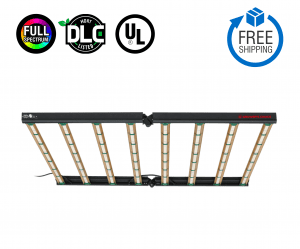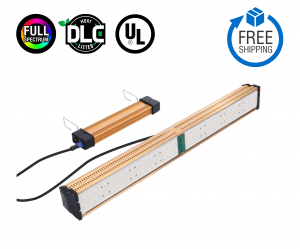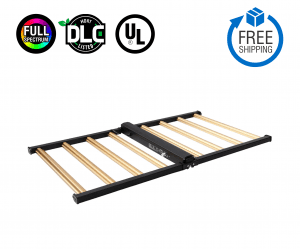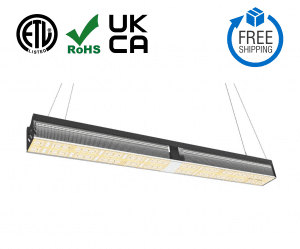
Brightway LED Lighting offers a wide selection of professional grade LED grow lights designed for indoor agricultural operations. LED lights give growers the ability to cultivate maximum yields while saving energy, maximizing efficiency and reducing ambient heat.
Is It Time For LED Grow Lights?
With more and more states legalizing, cannabis cultivators and connoisseurs are turning to LED grow lights in significant numbers for their indoor grows. Is this a fad or is LED technology the future of indoor growing?
As more indoor growers can produce a top-shelf product, the tide has turned in favor of the LEDs. Here we provide some critical considerations so you can choose wisely when investing in LED grow lights.
Advantages Of LEDs
By now most growers know the benefits of using LEDs for indoor growing—no scorching hot grow bulbs, lower power bills, healthier plants with superb taste and scent. The jury is still out on some other benefits, such as the LEDs’ ability to deter pests and bacteria.
What we do know is that LEDs are an excellent way to substitute away from energy-intensive HPS and metal halide bulbs; that is only if your light can produce enough of a harvest.
Popular Products
-
 LED Modular Commercial Grow Light – 1500W
LED Modular Commercial Grow Light – 1500W -
 LED Modular Commercial Grow Light – 960W
LED Modular Commercial Grow Light – 960W -
 LED Modular Commercial Grow Light – 720W
LED Modular Commercial Grow Light – 720W -
 LED Modular Commercial Grow Light – 480W
LED Modular Commercial Grow Light – 480W -
 LED Modular Commercial Grow Light – 240W
LED Modular Commercial Grow Light – 240W -
 LED Commercial Indoor Grow Light – 900W
LED Commercial Indoor Grow Light – 900W -
 LED Greenhouse Supplemental Grow Light – 730W
LED Greenhouse Supplemental Grow Light – 730W -
 LED Commercial Indoor Grow Light – 200W
LED Commercial Indoor Grow Light – 200W -
 Mars Hydro SP-6500 Samsung LM301B 650W Greenhouse LED Grow Light
Mars Hydro SP-6500 Samsung LM301B 650W Greenhouse LED Grow Light
| Apogee Instruments Inc. Published on Jun 27, 2019 |
LED Grow Lights Knowledge Base
How to use led grow lights
LED grows lights should be placed from 14 to 30 inches above the plants. One of the biggest advantages of using LEDs is that they put off so little heat. So, you can place them close to your plants without worrying about burning them.
What color should my grow lights be?
Red light stimulates vegetative growth and flowering (but if a plant gets too much, it will become tall and spindly). Blue light regulates plant growth, which makes it ideal for growing foliage plants and short, stocky seedlings (but too much will result in stunted plants).
Does watts matter for grow lights?
Yes. Much like a human sunburn, your plants can burn or bleach if you use too much light. More wattage may mean more light output, but it also means more heat output, which can lead to burned plants.
What Color Light is Best for Plant Growth?
Violet-blue light in the 400 – 520 nanometer range encourages chlorophyll absorption, photosynthesis, and growth. Red light in the 610 – 720 spectrum range promotes flowering and budding.
How many watts does a grow light need to be?
As a rule of thumb, aim for 20 to 40 watts per square foot. A good rule-of-thumb for LED grow lights is 32 watts of actual wattage per square foot of growing space for flowering medical or other large flowering plants.
How long should LED grow lights be on plants?
To be effective, grow lights really need to be on for at least 8-10 hours a day. This can vary up to 16 hours, depending on the conditions. That’s why LED grow lights are so popular – when they have to be left on all day, it’s best to use an energy efficient type!
Can you leave LED grow lights on all the time?
In general, you should not leave grow lights on 24/7. Plants need a light-dark cycle to develop properly. It’s believed that they truly do “rest” during periods of darkness, and probably use this time to move nutrients into their extremities while taking a break from growing.
What setting should I put my grow light on?
For vegetative growth, you should use lights that are in the 5,000-7,500 Kelvin range. As your plant enters into the flowering and fruiting stages of its life cycle it will need more of the red spectrum of light at the lower end of the kelvin scale.
How high should I hang my LED grow light?
LED grow lights are designed to be mounted between 6-12 inches from the canopy for maximum yields. This close proximity is possible because they produce substantially less heat than their HPS counterparts.
Do grow lights use a lot of electricity?
Some grow lights are fairly low powered, using as little as 10 watts in use. Others could easily draw up to 100 watts or more (ten times as much). Your electricity rates. Electrical use is measured in Kilowatt Hours (kWh) and generally, a single kWh will have a set price.
Do plants grow faster with LED lights?
Data analysis concludes that LED lights produce the necessary wavelengths of light needed in plant growth. The plants grown under LED lights produced growth that exceeded that of the plants grown under fluorescent lights.
What is the lifespan of an LED grow light?
LED grow lights typically last for 50,000 hours or more, whereas HID bulbs generally last 10,000 to 18,000 hours, depending on the specific type of bulb. When it comes to longevity, there’s really no competition. A major advantage of using LED grow lights is the huge spectrum of energy they provide.
Is 12 hours of grow light too much?
It is ideal to keep a grow light on for about 12 to 18 hours. Too much light in various growth phases can interrupt a weed plant’s natural process of growth and dormancy.
Can all plants go under a grow light?
LED grow lights are energy-efficient, cost-effective, and provide an ideal light spectrum for all types of plants.
When should grow lights be turned on?
The answer to this one is simple. Your grow lights should be turned on (or your seedlings should be put under lights) as soon as the first seed starts to sprout. Many types of seedlings grow very fast, and they will begin reaching for the light as soon as they emerge. So give them plenty of it right from the start.